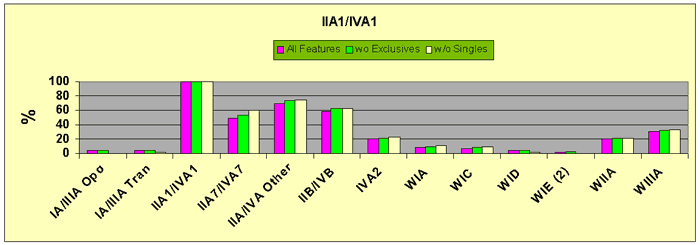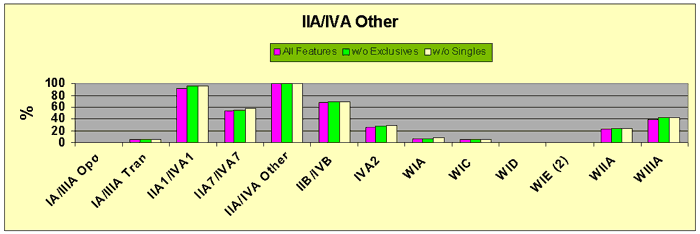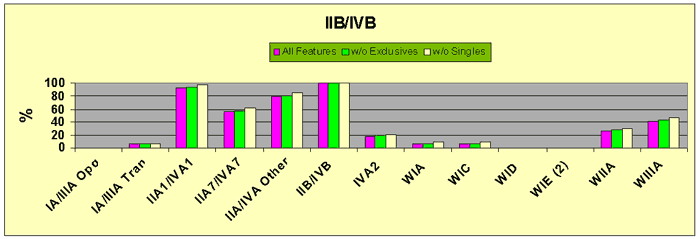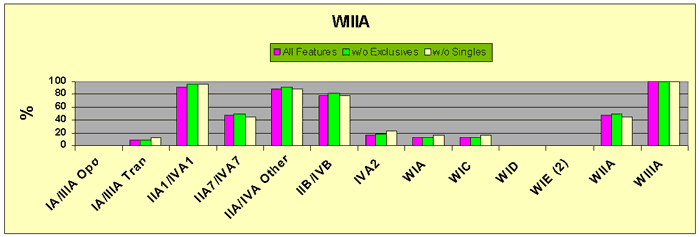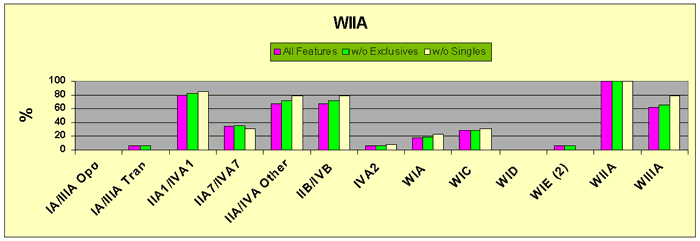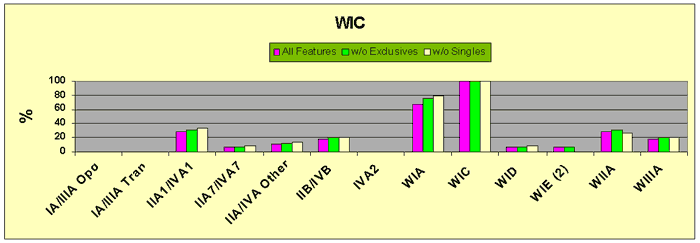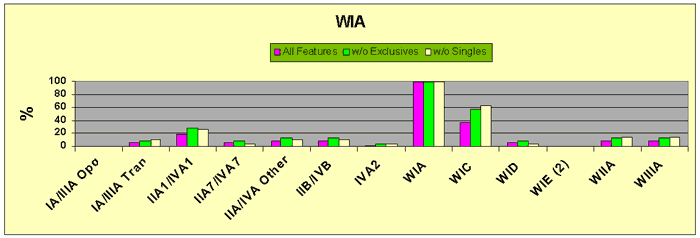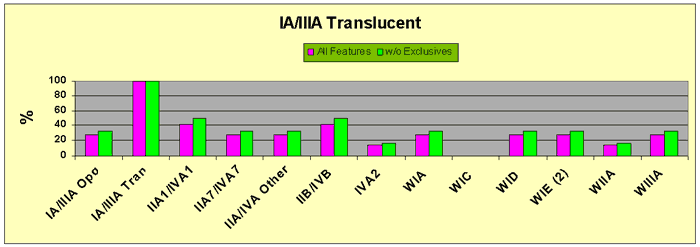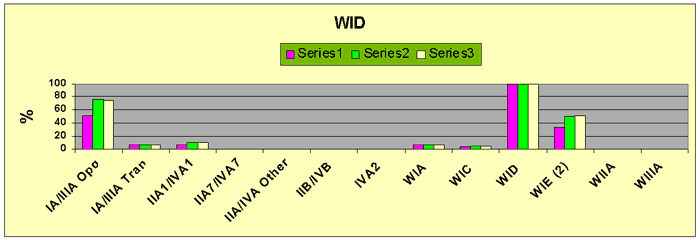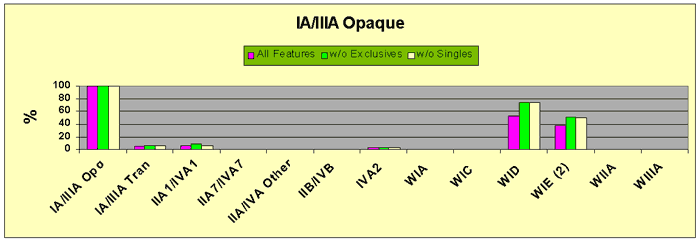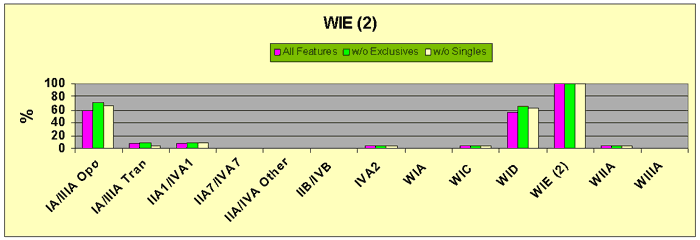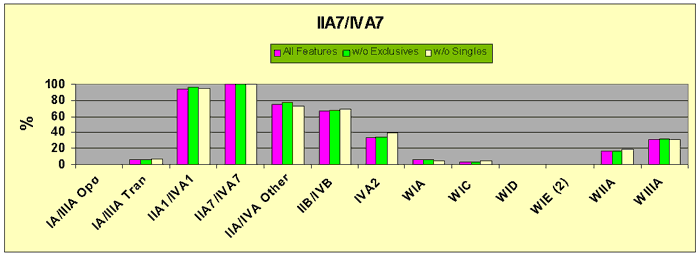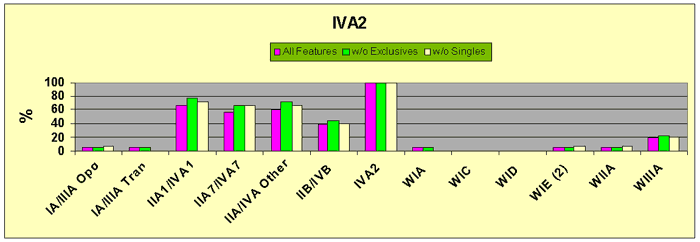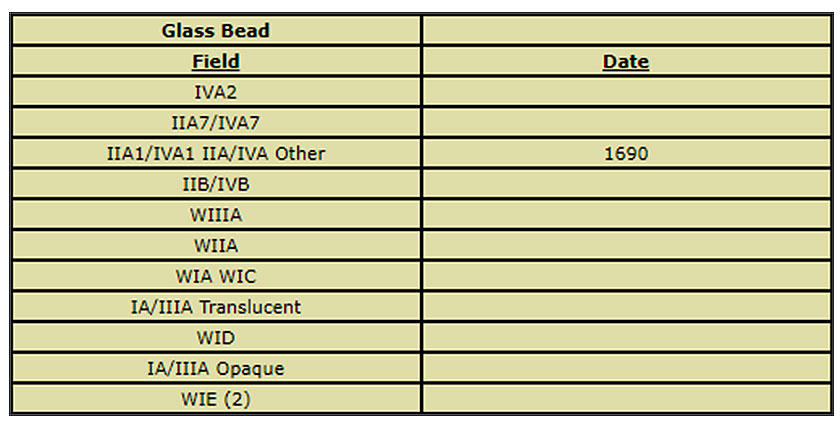
Glass Bead Sequence - Graphs
The first thirteen ranked major glass bead fields from Table 2 "Rank Feature" will be presented graphically. The graphs were generated from database sorts for each major glass bead field. The number of features (not bead specimen counts) is counted for each sort and used to determine the % association of the major glass bead fields.
The graphs demonstrate a set of up to three charts for each major glass bead field - 'All Features', 'w/o Exclusives' and 'w/o Singles'. The 'All Feature' represents every feature in which the major glass bead occurs, including exclusive and single bead features. For example, IIA1/IVA1 occurs in 69 features. Given this, 69 features are used for the chart 'All Feature'. The 'w/o Exclusives' chart represents only those features with other glass bead associations or the non-exclusive bead features. Continuing the example with IIA1/IVA1- it occurs in five features exclusively; therefore, 64 features are included in the chart. The last chart 'w/o Singles' eliminates the single bead and exclusive features of the graphed feature bead field. For IIA1/IVA1, 8 features had single beads, so the divisor eliminates all single bead and exclusive beads. For IIA1/IVA1, 56 features are charted. Note that for each major bead field graph, that bead has a 100% association on each chart.
The 'All Features' chart may represent the view of the bead field with the most association skew; given the appearance of exclusives and singles charts. The 'w/o Exclusives' chart removes the features that do not contribute to glass bead associations. The bead fields with a number of exclusive occurrences may indicate shifts in ornamentation and/or the representation of the bead as a native ornament. These concepts will be presented in the conclusions.
Of the three charts, the 'w/o Singles' may represent the purest view of the bead field and most importantly, its associations. Single beads, see Table 2, may indicate the use of heirlooms. Certainly two features, one from a collector and one from an archaeologist (Brad Lieb personal communication), produced a single glass bead within the fill above the feature (burial).
The bead sequence will be developed using the major bead graphs and Table 4. For each bead field, predecessor and successor bead fields will be examined using their respective charts. The progression of the sequence should demonstrate graphically the bead type/variety increase then decrease numerically within the sequence. The formative sequence shown on table 4 will serve as a guide for presentation of the bead fields.
To develop a bead field chronology there must be a temporal beginning. Given that we have assigned a formative major glass bead sequence based on shell and silver occurrences and have seen that the trade started years before sustained trade, we should expect the number of features with beads to dramatically increase when trade is sustained.
Major Glass Bead Graphs
IIA1/IVA1 is the first sustained trade bead type/variety. Recall from Table 3 that IIA1/IVA1 was found in 69 of the 187 features or 36.9%, the highest percentage of any of the bead fields. Note too that IIA1/IVA1 actually represents two varieties of bead, not types. IIA1/IVA1 dominates a number of major glass bead associations because of the high number of features. Figure 7 provides the three charts of association with the other major glass bead fields.
Figure 7 IIA1/IVA1 Major Glass Bead Feature Associations
Figure 7 demonstrates the relationship of features that contained the IIA1/IVA1 bead type/variety. Note that IIA/IVA Other has the highest association among the major beads and is the next bead in our chronology. Note Table 4 and Figures 5 and 6 to view IIA1/IVA1 place in the chronology.
Figure 8 IIA/IVA Other Major Glass Bead Feature Associations
IIA/IVA Other is almost 100% associated with IIA1/IVA1. We may conclude that they date very similarly. To confirm this on Table 4 we see that the % associations with shell are very close. Note that the associations of both to IIA7/IVA7 is also very similar. Figure 9 indicates that the next bead in the sequence is IIB/IVB, as does Figure 5.
Figure 9 IIB/IVB Major Glass Bead Feature Associations
IIB/IVB appears to graphically to have a high relationship to IIA1/IVA1. Figure 5 indicates the next major bead type/variety in our sequence is WIIIA. Like Figure 5, Figure 9 indicates a large gap in association when looking forward in time at WIIIA as opposed to looking back in time at IIA/IVA Other. This indicates a lapse in the sequence.
Figure 10 WIIIA Major Glass Bead Feature Associations
On Figure 10 WIIIA demonstrates strong relationships to the previous beads in the sequence. Graphically WIIA is the next bead in the sequence. Note that WIA and WIC have emerging relationships when compared to Figure 9. Figure 3 confirms the place of WIIA next in the sequence.
Figure 11 WIIA Major Glass Bead Feature Associations
Figure 11 demonstrates that WIIA maintains strong relationships to the previously sequenced beads. The next bead in the sequence is WIA (see Figure5) or WIC (see Figure 11).
Figure 12 WIC Major Glass Bead Feature Associations
On Figure 12, WIC represents the first bead in our sequence to show clear separation from IIA1/IVA1, IIA/IVA Other and IIB/IVB. Even the previous bead WIIA shows minor association. WIC did not demonstrate any relationship to shell on Figure 5 and only a slight relationship to silver on Figure 6. Clearly, this bead represents a bead sequenced (and dating) between these two artifacts. WIA is the next bead in our sequence.
Figure 13 WIA Major Glass Bead Feature Associations
The signature of WIA looks almost identical to WIC, Figure 12. The relationships to shell and silver on Figures 5 and 6, respectively, appear very similar to WIC. Therefore, WIC and WIA should be sequenced together. We must rely on Figure 6 to predict the next sequenced bead, IA/IIIA Translucent.
Figure 14 IA/IIIA Translucent Major Glass Bead Feature Associations
On Figure 14, note that IA/IIIA Translucent does not have any single bead features. This bead type occurs with WIA but not WIC. The graph also demonstrates relationships to the beads that were most prevalent with Silver- WID and IA/IIIA Opaque, Figure 4. The next bead in our sequence is WID.
Figure 15 WID Major Glass Bead Feature Associations
WID has lost association with most of the earlier sequenced beads. Only the beads that appear with silver, Figure 6 demonstrate relationships. IA/IIIA Opaque is the next bead in our sequence.
Figure 16 IA/IIIA Opaque Major Glass Bead Feature Associations
The graph of IA/IIIA Opaque is remarkably similar to WID, Figure 15, save WID demonstrates more relationship to the earlier sequenced beads. WIE (2) is the next bead in our sequence per Figures 15 and 6.
Figure 17 WIE (2) Major Glass Bead Feature Associations
WIE (2) has a graphic signature that does not clearly demonstrate a successor bead. From a predecessor standpoint, WID is slightly less associated than IA/IIIA Opaque. WIE (2) represents the last major bead in the sequence. However, Table 4 indicates that we have left two major beads out of the sequence, IIA7/IVA7 and IVA2.
Figure 18 IIA7/IVA7 Major Glass Bead Feature Associations
On Figure 18 IIA7/IVA7 demonstrates a signature of close association to IIA1/IVA1. Figure 5 indicates that the relationship to shell differs from IIA1/IVA1. We sequence IIA7/IVA7 prior to IIA1/IVA1.
Figure 19 IVA2 Major Glass Bead Feature Associations
Note that the associations to the later sequenced beads, IIA1/IVA1 and IIA/IVA Other, are diminished compared to IIA7/IVA7. IVA2 represents the earliest major bead in the Chickasaw sequence. The reader may wish to review the sequence graphically beginning with IVA2.
Table 5 Glass Bead Sequence
Table 5 indicates the sequence of the major glass beads within the Chickasaw database. Before dating the major bead type/varieties sequence, the minor beads will be graphed and added to the sequence. Note that one bead type, IIA1/IVA1 was given the date of 1690- the date of sustained trade.
The sequence of the major glass bead fields generally indicates that the drawn beads were in use prior to the wire-wound mandrels among the Chickasaw. More will be said about the bead chronology after the minor bead(s) additions.
